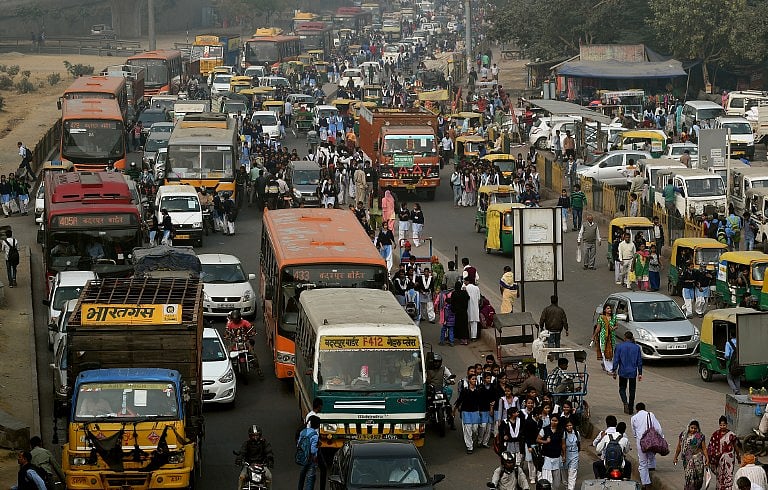
Is Odd-Even Formula The Best Solution To Delhi's Woes?
The Delhi government’s decision to experiment with licence plate movement restrictions has set off a welcome debate on urban congestion and air quality. Mexico City, Bogota, Beijing and a few other cities have experimented with this travel demand management (TDM) measure with varying degrees of success.
While it’s good to look at global examples, one must put such findings in the right context. For instance, Mexicans in a typical year drive 84.5 billion vehicle-kilometres. Indians, on the other hand, even by the most conservative (back of the envelope) estimates, drive 28 billion vehicle-kilometres per year. Further, the per capita vehicle ownership in Mexico is 0.275 while that in India is 0.018. These are important data points that influence the number of trips made. We see that even in a metropolitan city like Delhi, where only 20 percent of all trips are undertaken using private vehicles – cars and two-wheelers combined. These statistics indicate that India is not as automobile-dependent as Mexico and hence the probability of people buying a second car solely because of this experiment is quite low.
In my opinion, this experiment, if carried through, will indeed result in a drop in the number of cars on the road and will not increase car ownership in any significant manner. I do, however, expect an increase in the use of two-wheelers, public transport and radio cabs, a bit of car-pooling, and a lot of violations. The substitution of cars with two-wheelers and violations might significantly limit the expected benefits. Unfortunately, without robust data, we’re all shooting in the dark and a realistic answer on whether this experiment succeeds or not can only be obtained either through a simulation modelling exercise or through a well-planned scientific experiment.
Even if this experiment yields desired results, which it might in a limited way, we ought to address equity concerns too. A lot of women on social media rightly voiced their concerns about this scheme’s impact on their working life and it is a very valid concern. Delhi Metro is woefully inadequate to handle the current demand and its women’s compartments especially are bursting at the seams. I suspect Delhi Metro doesn’t have any spare capacity to accommodate additional riders that may choose to use Delhi Metro as a result of this experiment.
Then there are others, both men and women, who do not have access to Delhi Metro at all because they live live/work in areas not connected by it. Additionally, our public infrastructure is highly discriminatory against people with impaired mobility and that includes pregnant women and the elderly. For people belonging to this group, access to a private vehicle is not a luxury but a basic necessity and this experiment will hurt them the most, forcing them to either violate the law or sit at home two or three days a week, unless the government gives them an exemption which creates another enforcement challenge.
It appears that the Delhi government got jolted by a spate of alarming news reports on Delhi’s worsening air quality and pressed the panic button. As desperate as the situation may be there aren’t any short cuts to a solution. There are, however, several low hanging fruits that ought to be plucked in the medium term while we pursue sustainable long term solutions:
- Don’t let traffic police do the job that ought to be done by traffic engineers. Hire Traffic Operations Engineers to manage the city’s traffic signals. Indian cities are notorious for running long signal cycles. Long signal cycles mean longer delays and idling times and longer idling means more pollution. To put things in perspective, a typical signal cycle in most developed countries is 120 seconds (two minutes) although everyone prefers going lower if possible. In India, cycle times start from 120-150 and go up to 300 (five minutes) and beyond. Anything above 150 is a Jupiter-sized red flag but seems to go unnoticed in India. This may seem trivial but when aggregated over all signals and all vehicles, adds up pretty quick.
- Our roads operate at 50-60 percent of their capacity because a vast majority of motorists either lack driving skills or civic sense or both. It may sound clichéd but strict enforcement of traffic rules can have a meaningful impact in reducing delays, braking, and idling, and of course accidents too. If Delhi Police can enforce licence plate rationing, then it can enforce basic traffic rules much better.
- As mentioned previously, only 20 percent of all trips in Delhi are undertaken by private modes. But if you look around, you will hardly find any cycle lanes or footpaths. Look how we’ve made metros prohibitively expensive by restricting them to either overhead or underground just to subsidise roads. To put things in perspective, a Metro can transport 45,000 passengers per hour in one direction while a six-lane road (three lanes in each direction) can transport at most 6,000-8,000 passengers per hour per direction. Common sense would suggest that the Metro be at-grade (building entrance level) and roads either underground or elevated but we don’t do that and in the process end up incentivising private vehicles and inflating the cost of building quality public transport. If things have indeed reached such an alarming state that justify licence plate rationing and congestion pricing, then I believe the time is right to adopt road diet schemes to reduce vehicular lanes to accommodate public transport, pedestrian and cycling corridors.
Congestion and pollution are essentially land use problems and need a multi-dimensional effort to mitigate their impact. One strategy by itself will not solve these problems. For more on that I’d like to direct you to my other article for Swarajya— Avoid – Shift – Improve.